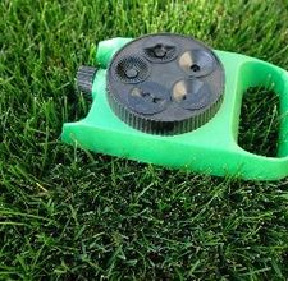Watering Practices
 Proper watering practices are required throughout the year for your lawn’s best appearance. Proper lawn watering is essential during drought periods to be effective and to conserve water.
Proper watering practices are required throughout the year for your lawn’s best appearance. Proper lawn watering is essential during drought periods to be effective and to conserve water.
Amount:
Lawn grasses have a minimum water requirement each week throughout the growing season. Any quantity less than this amount limits the turf grass vigor and ultimately results in dormancy. During hot weather, your lawn’s water requirements increase considerably. At this time, water needs to be supplemented by using lawn sprinklers. For best results, 1/2-1″ of water should be applied each time you water your lawn. This amount of water will moisten most soils to a depth of 5-7″. The best way to determine the amount of water the lawn has received is to place a container (a coffee can is ideal) in an area where your sprinkler or irrigation system is operating. Then, clock the time required to collect 1/2-1″ of water to determine the length of watering cycle. Another method of measure is to probe the soil with a long screwdriver to determine if the soil is moist to a depth of 5-7″. Rainfall during the week will help meet your lawn’s needs and reduce the watering time required. If you have heavy clay or compacted soil, water may tend to puddle in your lawn after a relatively short time of watering. If this occurs, water for 20-30 minutes, turn the sprinklers off for 20-30 minutes, and then water the same area again for 20-30 minutes. Repeat this cycle until the soil is moistened to the 5-7″ soil depth. A sloped lawn area should be watered in a similar manner to avoid water runoff and soil erosion.
Frequency:
Your lawn should be watered one to three times a week, depending on weather and soil conditions. Typically, lighter and more frequent watering is undesirable because it may result in shallow turf grass roots, weed germination and disease susceptibility. However, there are circumstances when lighter, more frequent watering is acceptable. This type of lawn watering is more effective for sandy soils, since water tends to move quickly and is eventually lost for plant availability. Light, frequent watering is also appropriate when the lawn is injured from insects and certain diseases, when moisture is needed to help the plant survive.
Timing:
Lawn watering is most efficient during the early morning hours. Watering should not occur during daylight hours, as late evening and night watering can increase susceptibility to lawn diseases. However, if you cannot water during the day, evening watering is better than not watering at all.
Practices to Enhance Water Usage:
1. Proper, balanced fertilization of lawns: A well-nourished lawn requires less frequent watering.
2. Aeration: An annual program of aeration avoids soil compaction and rapid water runoff, increases water infiltration and promotes rooting.
Cultural Practices to Enhance Water Usage:
1. For most effective water use, avoid watering lawns on windy days.
2. Water early in the morning to reduce evaporation.
3. Avoid sprinklers that produce a fine mist (watering is lost to wind and evaporation).
4. Check irrigation systems frequently to inspect for leaks, sprinkler patterns and timer settings.
5. Adjust mower height to 3″ during drought stress periods.
The Green Pointe staff is always ready to assist you with your lawn care. Please call if we may provide any information to enhance your lawn’s health or appearance.
Please call our office if you have any questions or visit our “Questions” page to review other frequently asked questions and answers. (801) 261-1171
 Green Pointe Lawn Care
Green Pointe Lawn Care